Introduction
Navigating the world of Level 2 Autism can be overwhelming, yet understanding its nuances is crucial for ensuring the well-being of those affected. Level 2 Autism, or Autism Spectrum Disorder (ASD) Level 2, presents significant challenges in social communication and repetitive behaviors, necessitating substantial support. This article delves into the defining characteristics, diagnostic criteria, common symptoms, and effective support strategies for individuals with Level 2 Autism.
By exploring communication and social interaction issues, as well as the importance of early diagnosis and tailored interventions, it aims to provide comprehensive guidance for parents, caregivers, and educators to empower and support those with Level 2 Autism.
What is Level 2 Autism?
'Stage 2 of the spectrum, also referred to as Autism Spectrum Disorder Stage 2, is defined by considerable difficulties in interpersonal communication and repetitive actions that necessitate considerable assistance. People with Stage 2 developmental disorder often encounter challenges in interpreting social signals, establishing connections, and may display inflexible behaviors and opposition to change. Communication can be limited, with some relying on repetitive language or phrases. These symptoms can significantly affect everyday life, necessitating customized assistance strategies. 'In contrast to Stage 1, where minimal assistance is required, and Stage 3, where comprehensive intervention is vital, Stage 2 requires a balanced method to address the person's distinct needs effectively.'.
DSM-5 Classification and Criteria
The Diagnostic and Statistical Manual of Mental Disorders, Fifth Edition (DSM-5), offers comprehensive guidelines for identifying Category 2 developmental disorder, highlighting the necessity for significant assistance. These include persistent deficits in social communication and interaction across multiple settings, manifesting as significant challenges in understanding social cues and forming relationships. Additionally, individuals exhibit restricted and repetitive behaviors, such as repetitive language or rigid routines, which further impact daily functioning. For a diagnosis of Stage 2 of the condition, these symptoms must be severe enough to necessitate assistance, indicating a more pronounced impact on functioning compared to Stage 1 of the condition.
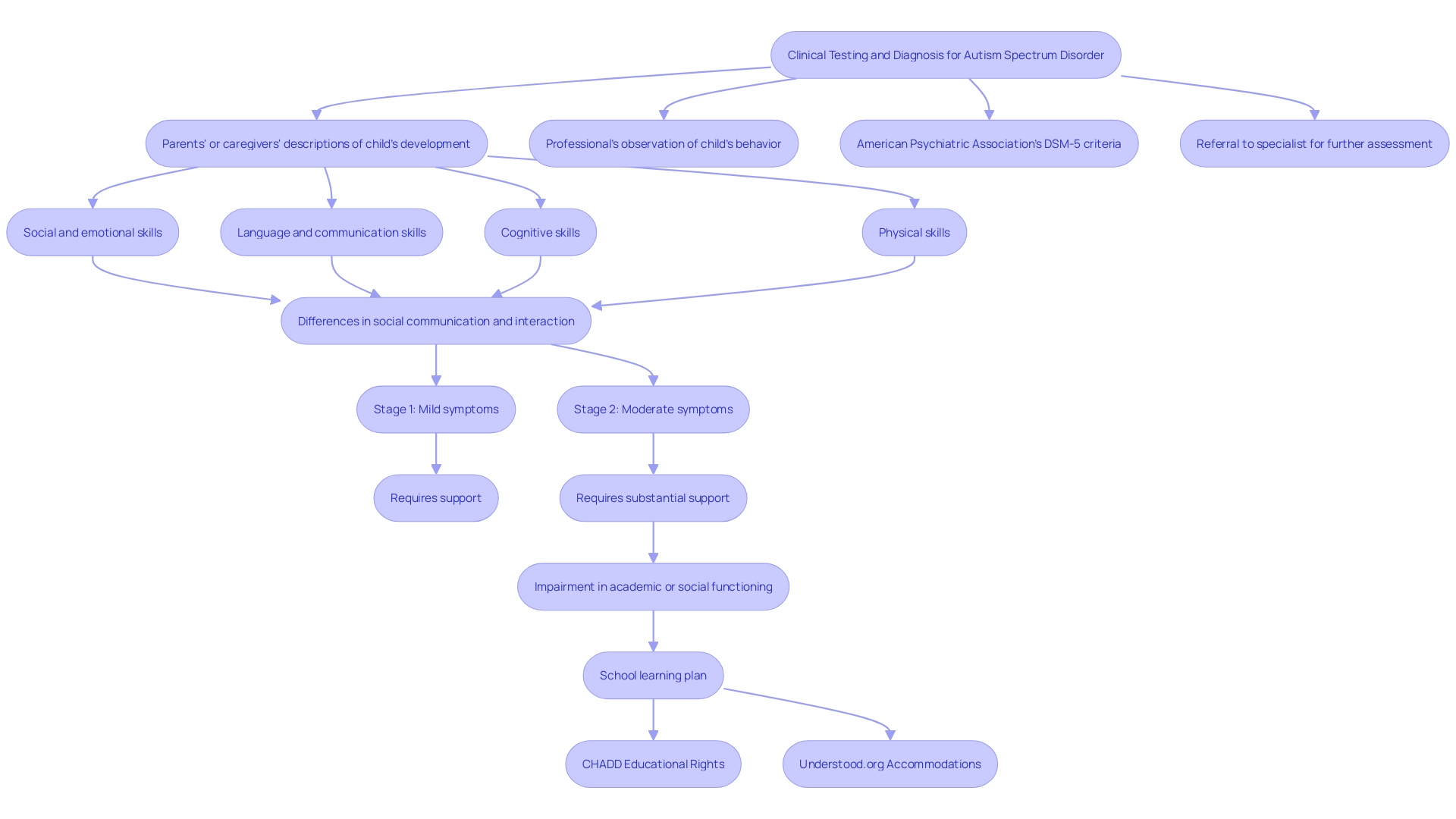
Common Symptoms and Traits of Level 2 Autism
Individuals with Level 2 Autism often exhibit a range of symptoms that significantly impact their daily lives. These symptoms include difficulty initiating and maintaining conversations, challenges in understanding interpersonal cues, and a tendency to engage in repetitive behaviors or intense interests. For example, individuals may have limited eye contact, struggle to understand jokes or sarcasm, and show resistance to changes in routine. According to recent research, about 1 in 45 adults in the U.S. are diagnosed with autism spectrum disorder (ASD). However, many adults may remain undiagnosed or misdiagnosed, having lived their entire lives without recognizing the signs of autism. This emphasizes the importance of awareness and understanding of common autism characteristics, such as social communication difficulties and restricted, repetitive behaviors. These challenges are not confined to childhood but persist into adulthood, requiring substantial support to navigate everyday interactions and routines.
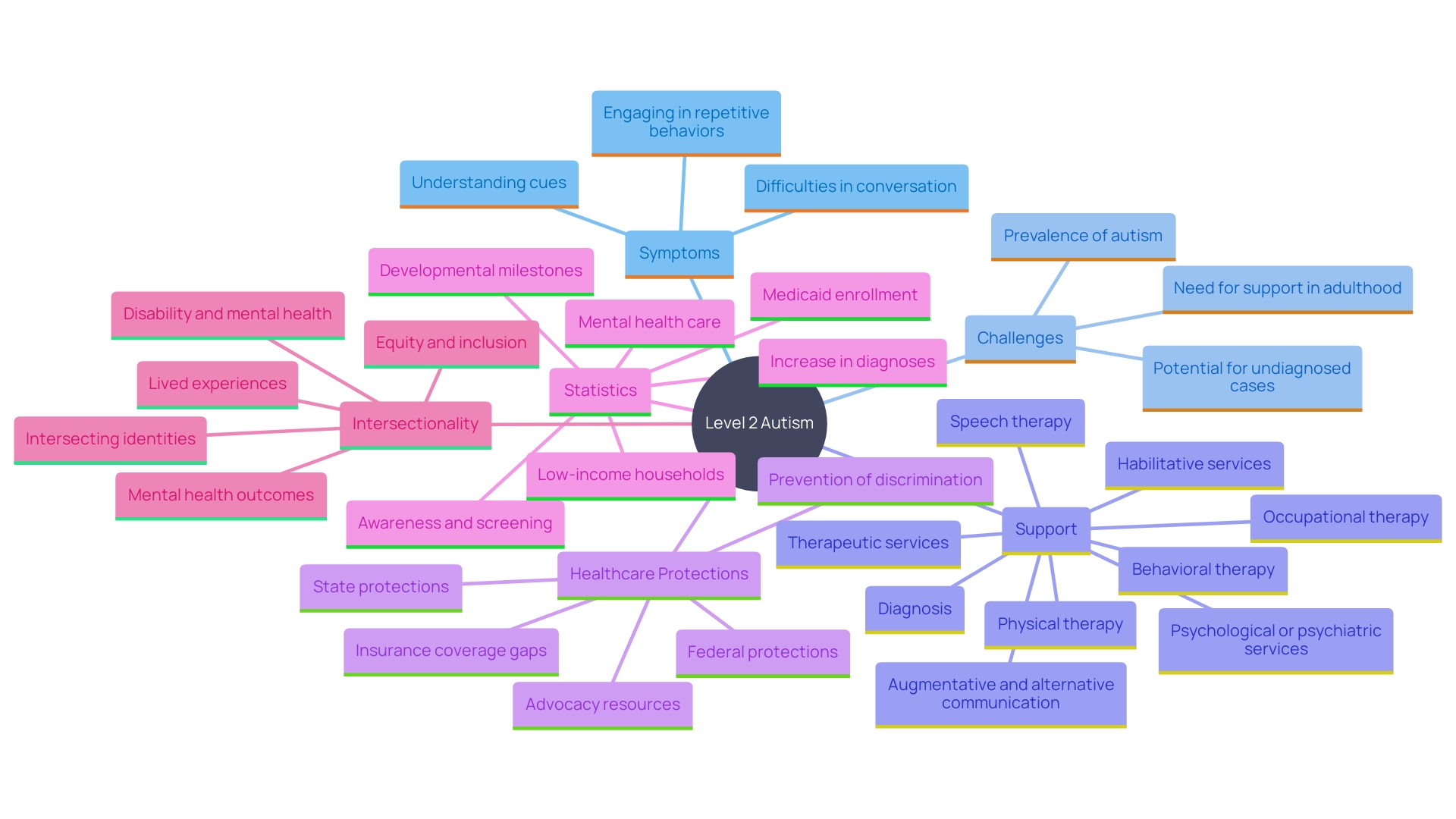
Communication Challenges in Level 2 Autism
Communication challenges are a defining feature of Level 2 Autism. Individuals often face significant struggles with both verbal and nonverbal communication. They may have a limited vocabulary, making it difficult to articulate their thoughts and feelings effectively. This can lead to frequent misunderstandings in interpersonal interactions, causing frustration for both the individual and their caregivers.
Research has shown that these communication barriers can significantly impact the mental health and well-being of autistic individuals. For instance, a study highlighted the difficulties autistic individuals face in adapting to changes in speech patterns, which can affect their ability to understand tone and meaning. This makes it even more challenging for them to engage in meaningful discussions and interactions with others.
Furthermore, innovative assessment methods have revealed that many nonspeaking autistic individuals possess a higher understanding of written language than previously believed. This underscores the potential for exploring alternative communication methods, such as written forms, to enhance their ability to express themselves and participate in educational, employment, and social opportunities.
Addressing these communication difficulties is crucial for ensuring that autistic individuals receive the right care and support. Person-centered care and collaborative decision-making depend significantly on strong communication abilities, making it crucial to create approaches that enhance comprehension and engagement for individuals with moderate developmental differences.
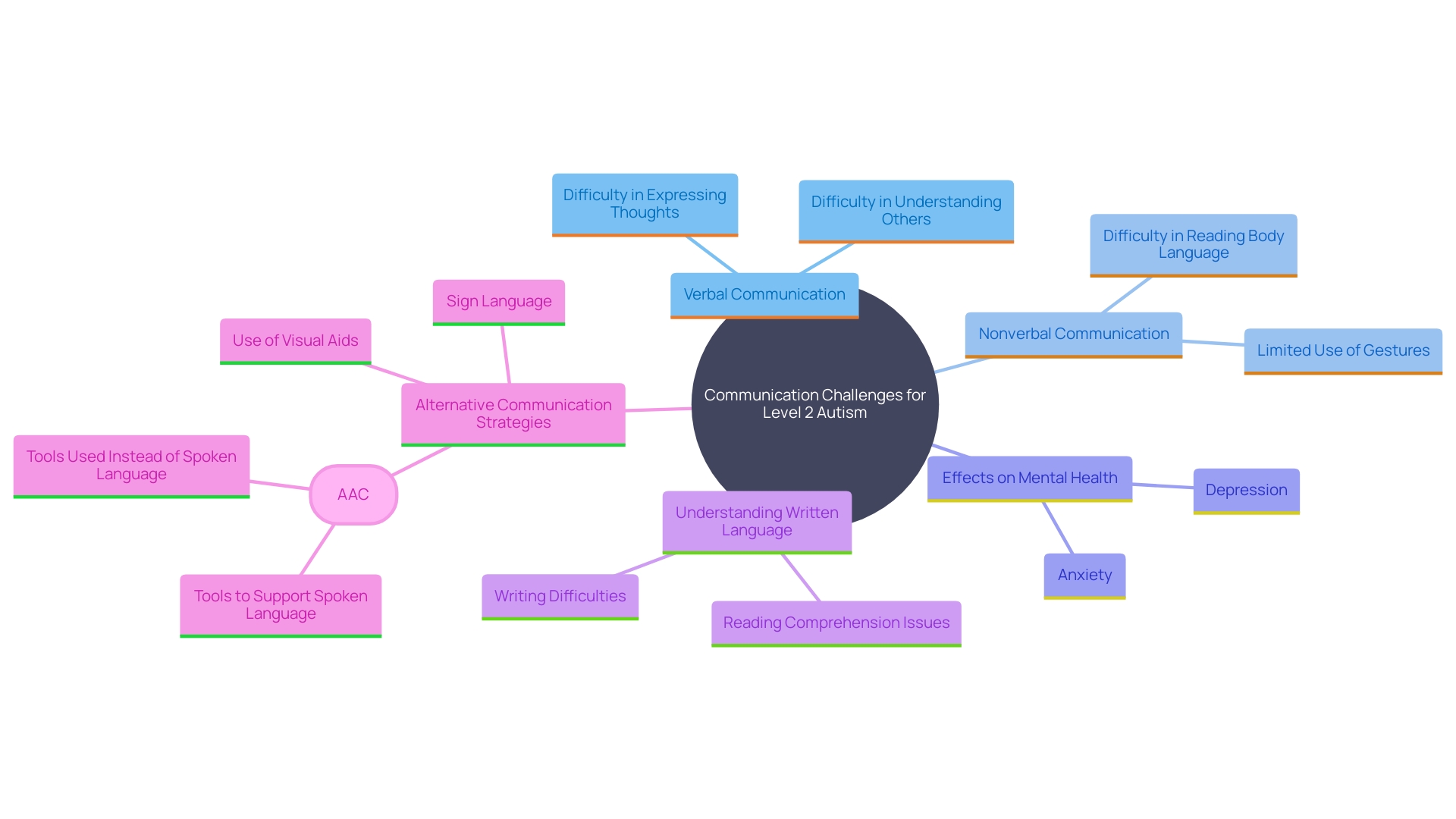
Social Interaction Issues in Level 2 Autism
Social interaction poses significant challenges for individuals with Level 2 Autism, often making back-and-forth conversations, interpreting body language, and forming friendships particularly difficult. These communal hurdles can lead to feelings of isolation and struggles in various interpersonal settings, including schools and community events. Evidence shows that developmental interventions, such as naturalistic developmental behavioral interventions, can improve social communication in interactions with caregivers, addressing core challenges associated with autism. The significance of these interventions is highlighted by the experiences of many parents who advocate for improved assistance systems. One study emphasized that parents, especially mothers of autistic children, frequently feel judged and stigmatized while navigating the system to obtain the appropriate assistance for their children. This underscores the need for a strength-based approach in training and support services to better address the unique needs of autistic individuals and their families.
Repetitive Behaviors and Interests in Level 2 Autism
Repetitive actions and concentrated passions are common among individuals with moderate autism spectrum disorder. These behaviors often manifest as repetitive movements, including hand-flapping or rocking, and intense focus on specific topics or activities. For instance, a study funded by the Fonds de Recherche du Quebec and other bodies revealed that 37% of autistic children showed an intense or exclusive interest in letters, compared to only 3% of non-autistic children. This can be particularly challenging as such behaviors, while providing comfort, may disrupt daily functioning and hinder social interactions. Additionally, 17% of autistic children displayed a heightened interest in numbers, making them 3.49 times more likely to have such interests than their non-autistic peers. Grasping these patterns is essential for creating efficient assistance strategies that can aid in managing these behaviors and improve the quality of life for individuals with Stage 2 developmental disorder.
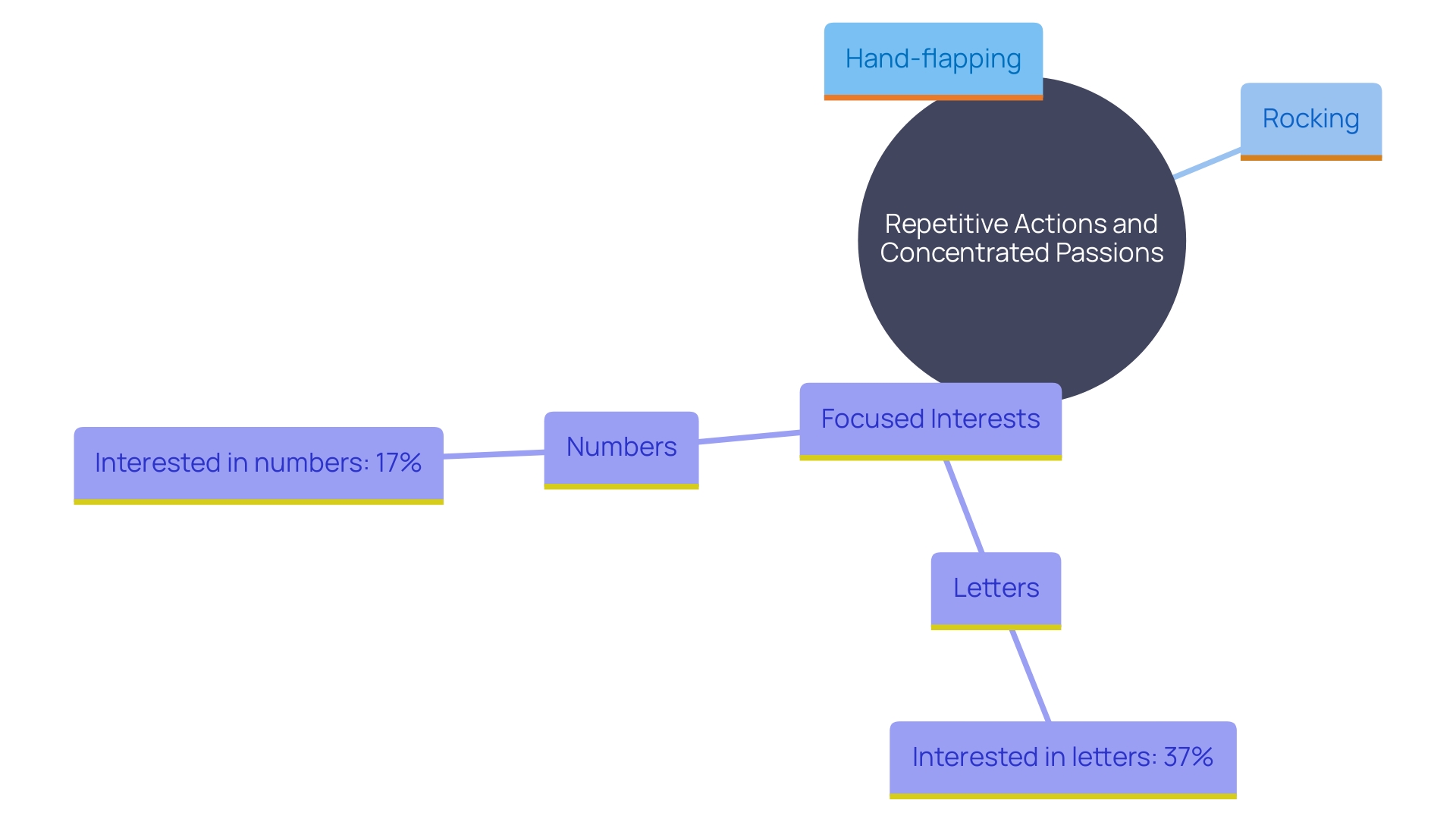
Diagnosis and Assessment of Level 2 Autism
Diagnosing Level 2 Autism involves a thorough and multi-faceted evaluation process by a qualified professional. This comprehensive assessment typically includes a detailed developmental history gathered from parents or caregivers, standardized assessments, and direct observation of the individual's behavior. The American Psychiatric Association's Diagnostic and Statistical Manual, Fifth Edition (DSM-5), provides standardized criteria to assist in diagnosing autism spectrum disorder (ASD), emphasizing the importance of early childhood symptoms.
For an accurate diagnosis, professionals often rely on multiple diagnostic tools and may involve specialists such as neurodevelopmental pediatricians, child neurologists, and developmental-behavioral pediatricians. Prompt identification is vital as it enables timely access to necessary assistance and intervention services. Research shows that early intervention, particularly developmental and behavioral therapies, can significantly improve social communication and adaptive behaviors, contributing to better long-term outcomes for children with autism.
Additionally, the Community in Action (TACA) assists numerous families by highlighting the significance of early intervention. Their efforts highlight the pressing need for diagnostic tools that can identify ASD as early as possible, thus shortening the typically long and challenging path to a diagnosis. Understanding and addressing these needs can help ensure that children receive the necessary support to thrive.
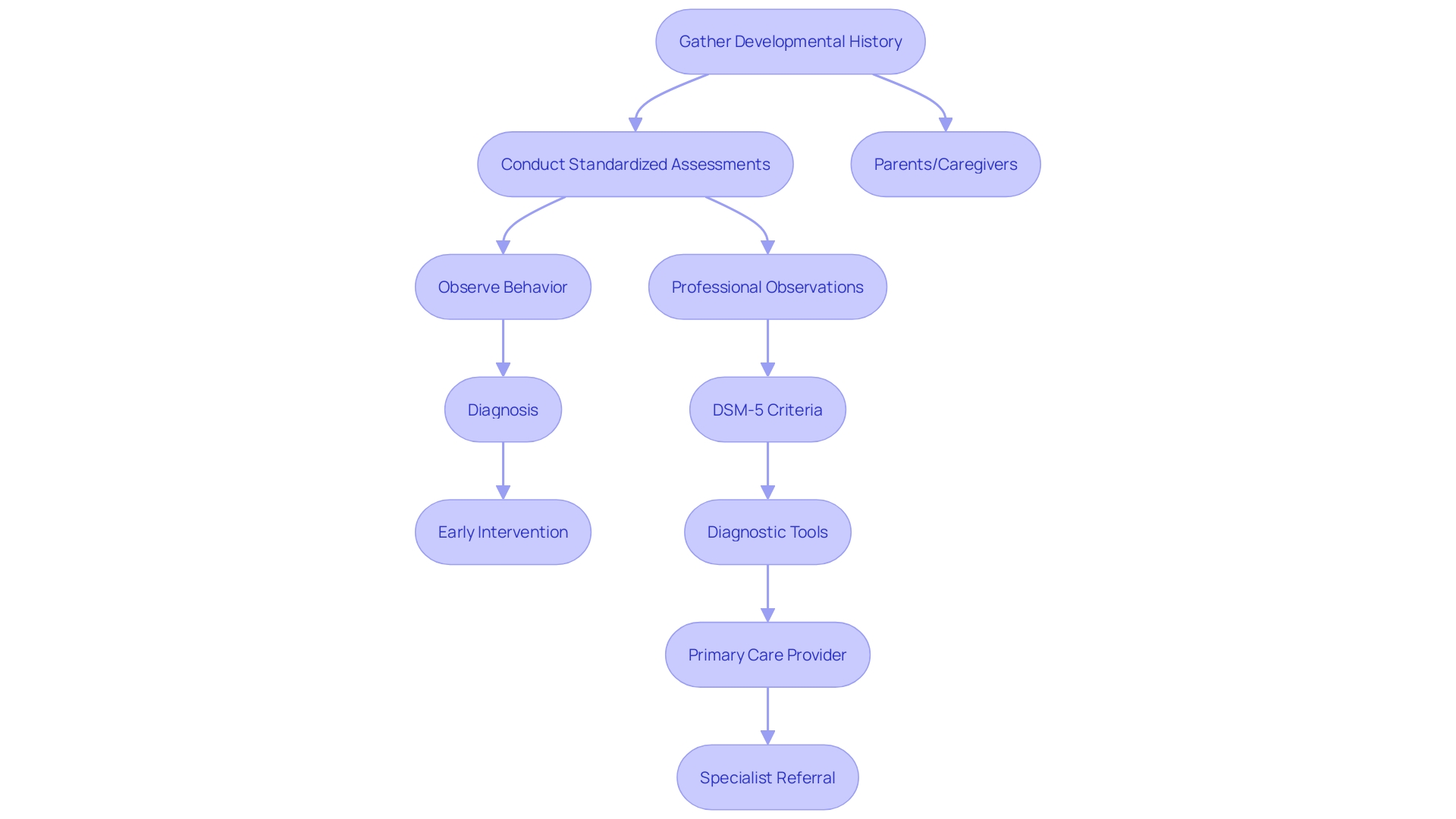
Support and Interventions for Level 2 Autism
Support for individuals with Level 2 Autism often involves a combination of therapies and interventions tailored to their unique needs. This can include speech therapy, occupational therapy, and interpersonal skills training. Evidence indicates that developmental interventions enhance communication during interactions with caregivers, and naturalistic developmental behavioral interventions tackle core challenges related to autism, especially issues with communication. Pediatricians and other doctors are frequently the primary source of care, guiding families to early childhood interventions to aid their development. These interventions are strongly recommended for young autistic children to promote skill gain in areas that might contribute to positive long-term outcomes.
In the United States, early intensive behavioral intervention is a commonly recommended approach, characterized by an intensity of 20-40 hours per week. In contrast, the National Institute for Health and Care Excellence in England supports lower intensity interventions like pediatric autism communication therapy and JASPER, which target early interpersonal communication interactively.
Families can also gain significantly from advice on establishing nurturing settings that encourage communication and interaction. Responsive and engaging parent-child interactions are associated with positive outcomes for autistic children. Providers are equipped to implement these interventions effectively, ensuring toddlers with early signs of autism have greater access to early, developmentally appropriate interventions that empower families and address core social difficulties.
Dr. Nicole Sharp, an occupational therapist, emphasizes the need for greater community awareness and upskilling of parents and teachers to facilitate the safe participation of autistic children, highlighting that autism is not something to be fixed or cured. Such awareness and encouraging surroundings play a vital role in the well-being and growth of individuals with Stage 2 developmental differences, ensuring they receive the essential assistance and opportunities to flourish.
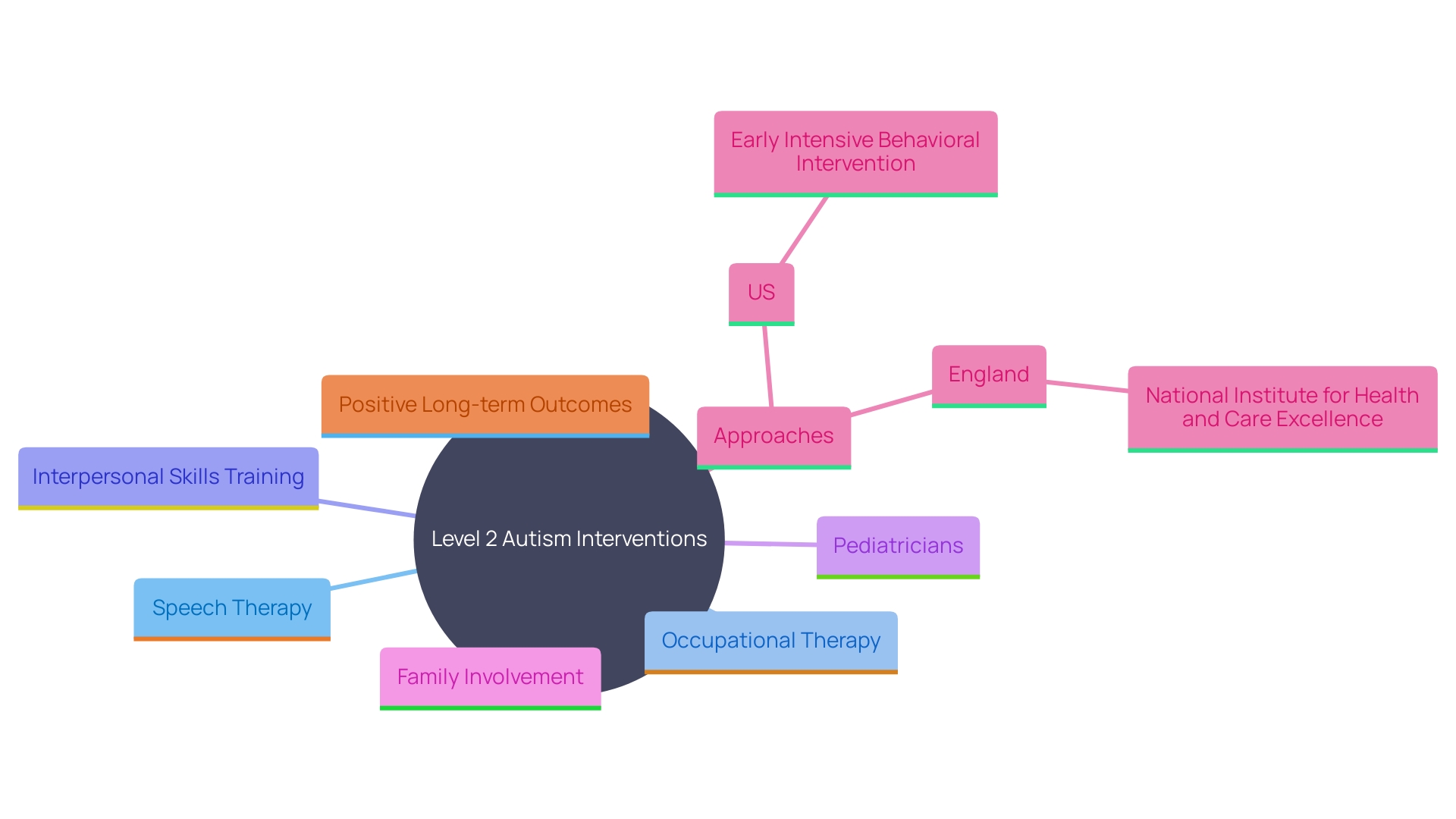
Educational Accommodations for Level 2 Autism
Educational settings play a crucial role in supporting individuals with Level 2 Autism. Accommodations like individualized education plans (IEPs), which can define session lengths and overall duration, are essential in providing organized assistance. Specialized teaching strategies tailored to the needs of students with autism, such as those that incorporate multi-component interventions, are essential. Sensory-friendly environments help these students thrive in school by reducing overstimulation and creating a conducive learning atmosphere.
Collaboration between educators, therapists, and families is vital for successful outcomes. This multifaceted approach ensures that students receive comprehensive support across various environments. For example, the College of New Jersey’s Career and Community Studies program serves students with autism and other disabilities, demonstrating the importance of inclusive programs. Such initiatives reflect the broader efforts seen in places like Washington state, where coordinated efforts have expanded access to inclusive education, enabling students to learn alongside their peers without disabilities.
Dr. Katharine Parham Malhotra's research further emphasizes that inclusive classrooms do not negatively impact the academic performance of students without disabilities. This inclusion benefits all students by fostering a diverse and supportive learning environment. As Assistant Secretary Glenna Wright-Gallo highlights, early inclusion sets the stage for continued success, allowing children with disabilities to achieve their goals and thrive in their communities.
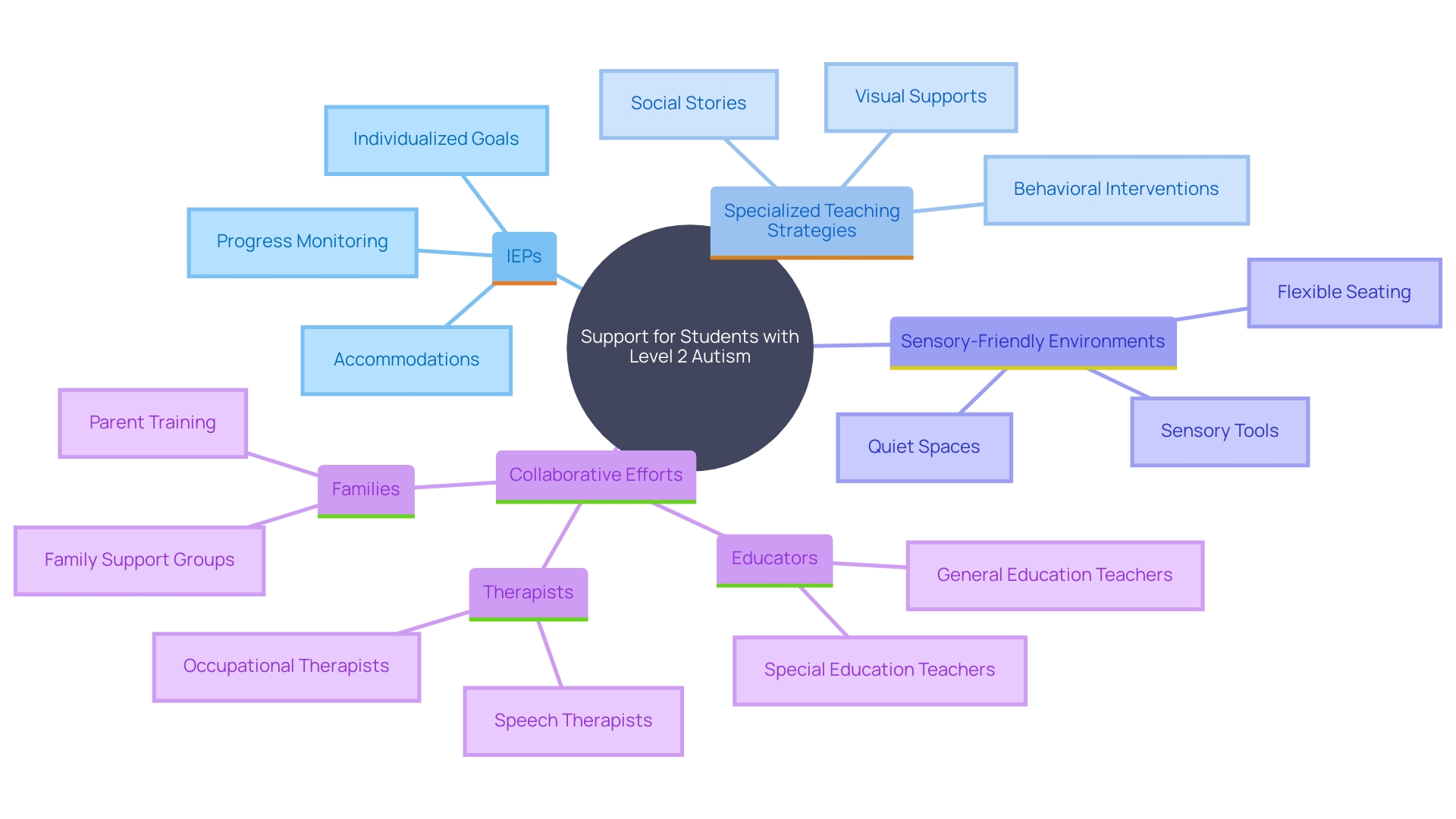
Strategies for Parents and Caregivers
Parents and guardians of children with Stage 2 developmental disorder can utilize a variety of strategies to foster their child’s growth and well-being. Establishing consistent routines is crucial, as it helps the child feel secure and understand expectations. Using visual aids for communication can significantly enhance understanding and expression, providing a clear and consistent mode of interaction. Promoting social interactions through structured activities is another essential strategy, as it encourages children to develop social skills in a supportive and predictable environment.
Establishing a strong assistance network is vital for families navigating Level 2 Autism. This network can include healthcare professionals, educators, and other families facing similar challenges, providing emotional assistance and practical advice. Accessing resources and early intervention programs tailored to the needs of children with autism can empower families and improve outcomes. Research has shown that early, developmentally appropriate interventions can enhance social communication skills and overall development, making a significant difference in the child's progress.
Moreover, raising awareness about neurodiversity and the unique strengths of autistic individuals can foster a more inclusive community. By understanding that autism is not something to be fixed but rather a different way of experiencing the world, communities can better support and celebrate the diverse abilities of all children. As Dr. Nicole Sharp, an occupational therapist, emphasizes, “There is also a need for greater community awareness of the fact that autism is not something to be fixed or cured.”
In conclusion, by employing these strategies and leveraging available resources, parents and caregivers can create a supportive environment that promotes the well-being and development of children with Level 2 Autism.
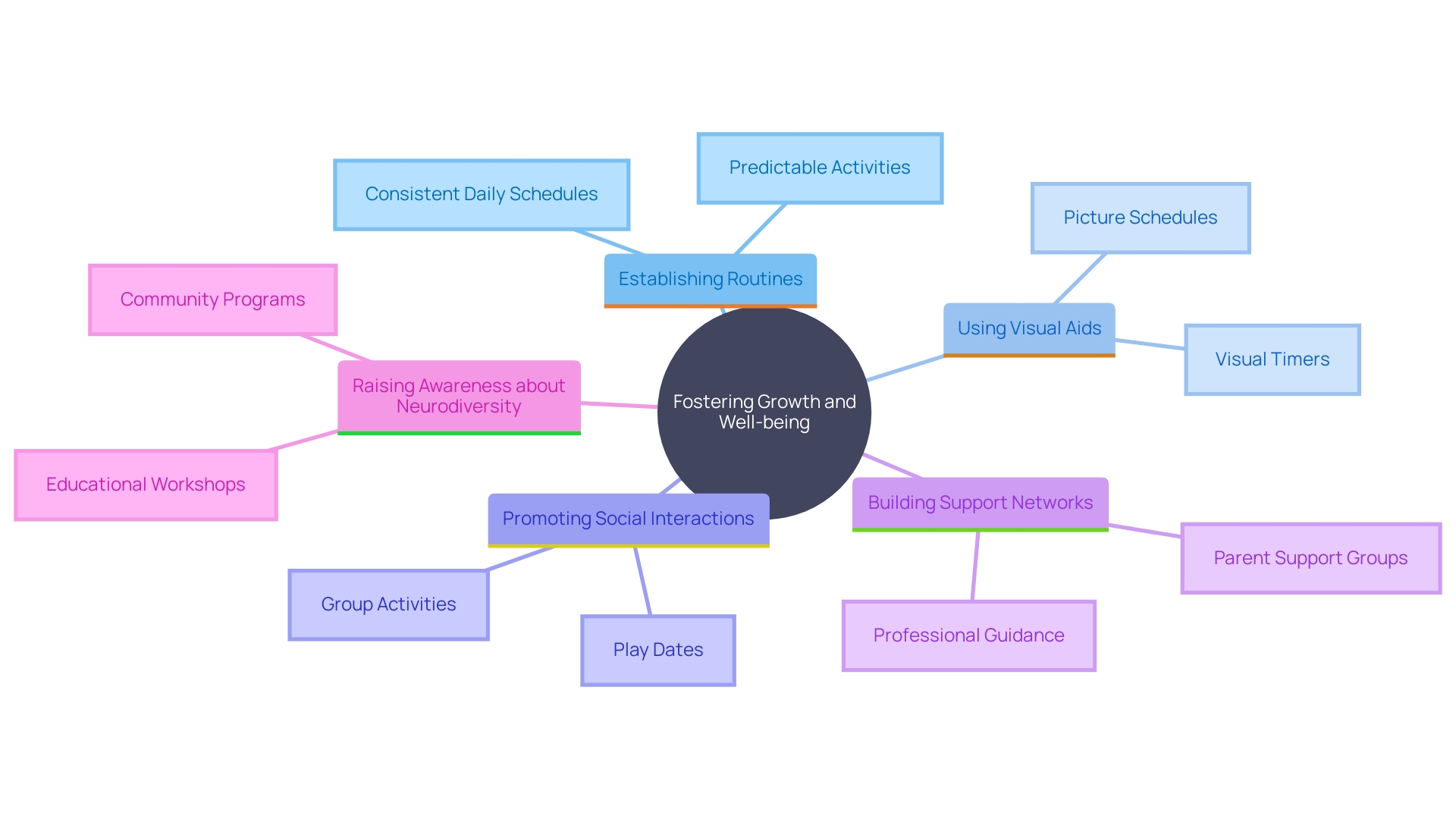
Conclusion
Understanding Level 2 Autism is essential for providing the right support and interventions necessary for individuals affected by this condition. The characteristics of Level 2 Autism, including significant challenges in social communication and repetitive behaviors, highlight the need for tailored approaches that cater to each person's unique needs. By recognizing the diagnostic criteria outlined in the DSM-5, caregivers can better navigate the complexities of this disorder and advocate effectively for their loved ones.
Communication and social interaction issues are prominent challenges, impacting the daily lives of individuals with Level 2 Autism. The importance of early diagnosis and intervention cannot be overstated; timely access to support services can lead to improved outcomes in social skills and overall functioning. Various strategies, including speech therapy and social skills training, are crucial in helping individuals develop the necessary tools to thrive in their environments.
Educational accommodations and community support play vital roles in fostering an inclusive atmosphere for individuals with Level 2 Autism. Implementing individualized education plans and creating sensory-friendly environments can significantly enhance learning experiences. Additionally, building a strong support network among families, educators, and healthcare professionals empowers parents and caregivers to advocate for their children effectively.
Ultimately, understanding and embracing the unique strengths of individuals with Level 2 Autism is key to fostering a supportive and inclusive community. By leveraging available resources and implementing effective strategies, families can ensure their loved ones receive the necessary support to navigate the challenges of autism and lead fulfilling lives.




